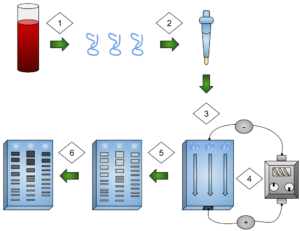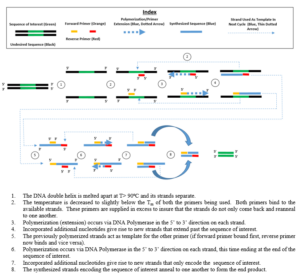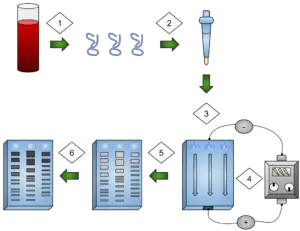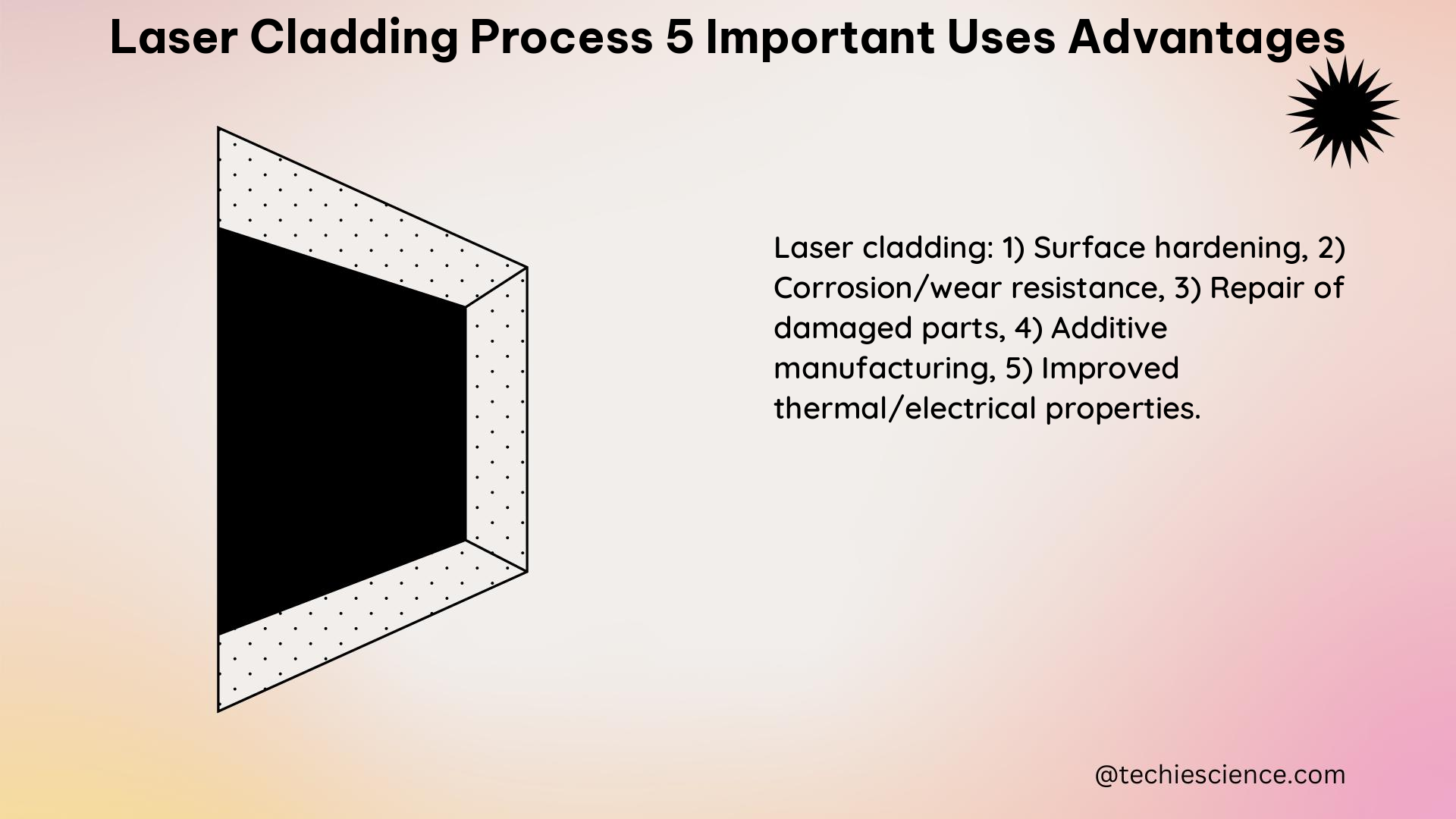The DNA splicing process, also known as genetic engineering or gene splicing, is a fascinating technique that allows scientists to manipulate and modify the DNA of an organism. By selectively cutting and recombining DNA sequences, researchers can introduce new genes or alter existing ones, leading to the creation of genetically modified organisms (GMOs) with desired traits. This process has revolutionized fields such as agriculture, medicine, and biotechnology, offering new possibilities for improving crop yields, developing novel therapies, and understanding the fundamental mechanisms of life. In this article, we will delve into the intricacies of the DNA splicing process, exploring its steps, tools, and applications. So, let’s embark on this journey into the world of genetic manipulation and uncover the secrets of DNA splicing.
Key Takeaways
- DNA splicing is a process that involves cutting and recombining DNA fragments.
- It is used in genetic engineering to create genetically modified organisms.
- DNA splicing can be done using restriction enzymes or CRISPR-Cas9 technology.
- The process allows scientists to insert or remove specific genes from an organism’s genome.
- DNA splicing has numerous applications in medicine, agriculture, and biotechnology.
DNA Splicing: An Overview
DNA splicing is a fundamental process in molecular biology that plays a crucial role in genetic engineering and the modification of DNA. It involves the manipulation and modification of DNA sequences to create new combinations of genes or to alter existing ones. This article provides an overview of the definition, significance, and types of DNA splicing.
Definition and Significance of DNA Splicing
DNA splicing, also known as gene splicing or DNA recombination, refers to the process of cutting and joining DNA molecules to create new combinations of genetic material. It is a key technique used in genetic engineering to introduce specific genes into an organism or to modify existing genes.
The significance of DNA splicing lies in its ability to manipulate the genetic material of an organism, allowing scientists to study gene function, develop new treatments for genetic diseases, and improve agricultural crops. By splicing DNA, researchers can transfer desirable traits from one organism to another, creating genetically modified organisms (GMOs) with enhanced characteristics.
Types of DNA Splicing
There are several types of DNA splicing techniques that are commonly used in molecular biology and genetic engineering. These techniques allow scientists to precisely modify DNA sequences and create desired genetic changes. Some of the most widely used types of DNA splicing include:
-
Recombinant DNA Technology: Recombinant DNA technology involves the combination of DNA molecules from different sources to create a new DNA sequence. This technique allows scientists to insert specific genes into a host organism‘s genome, enabling the production of proteins or the expression of desired traits.
-
Gene Splicing Techniques: Gene splicing techniques involve the cutting and joining of DNA molecules at specific sites. This can be achieved using enzymes called restriction enzymes, which recognize specific DNA sequences and cut the DNA at those sites. The cut DNA fragments can then be joined together using DNA ligase, resulting in the creation of a new DNA sequence.
-
DNA Recombination Methods: DNA recombination methods involve the exchange of genetic material between DNA molecules. This can occur naturally through processes such as crossing over during meiosis or can be induced in the laboratory using techniques like homologous recombination. DNA recombination allows for the exchange of genetic material between different DNA molecules, leading to the creation of new combinations of genes.
-
Gene Transfer and Gene Cloning: Gene transfer involves the transfer of genes from one organism to another. This can be achieved through various methods, such as the use of viral vectors or the direct introduction of DNA into cells. Gene cloning, on the other hand, involves the creation of multiple copies of a specific gene or DNA sequence.
These different types of DNA splicing techniques provide scientists with powerful tools for studying gene function, understanding genetic diseases, and developing new treatments. They have revolutionized the field of molecular genetics and continue to drive advancements in genetic engineering and biotechnology.
In conclusion, DNA splicing is a vital process in molecular biology that allows scientists to manipulate and modify DNA sequences. It plays a significant role in genetic engineering, enabling the creation of genetically modified organisms and the study of gene function. With various types of DNA splicing techniques available, researchers have the means to make precise genetic modifications and contribute to advancements in fields such as medicine, agriculture, and biotechnology.
Steps of the DNA Splicing Process

The DNA splicing process, also known as gene splicing or DNA recombination, is a fundamental technique in genetic engineering and molecular biology. It involves the manipulation and modification of DNA to create recombinant DNA molecules with desired genetic traits. This article will outline the key steps involved in the DNA splicing process, providing a comprehensive understanding of this important technique.
DNA Isolation
The first step in the DNA splicing process is the isolation of the DNA molecule from the source organism. This can be done by extracting DNA from cells or tissues using various methods such as cell lysis, enzymatic digestion, or mechanical disruption. The goal is to obtain a pure sample of DNA that can be further manipulated in the laboratory.
Digestion of DNA using Restriction Enzymes
Once the DNA is isolated, the next step is to digest it using restriction enzymes. Restriction enzymes are proteins that recognize specific DNA sequences and cut the DNA at those sites. These enzymes act as molecular scissors, cleaving the DNA into smaller fragments. The choice of restriction enzymes depends on the desired DNA fragments and the specific application. After digestion, the DNA fragments are ready for further manipulation.
Amplification of the Digested DNA

After digestion, the digested DNA fragments need to be amplified to obtain a sufficient amount of DNA for subsequent steps. This is typically done using a technique called polymerase chain reaction (PCR). PCR is a powerful method that allows for the rapid and exponential amplification of specific DNA sequences. It involves a series of heating and cooling cycles that facilitate the replication of the DNA fragments. Through PCR, millions of copies of the DNA fragments can be generated from a small starting amount.
Ligation of the Amplified DNA

Once the DNA fragments are amplified, the next step is to ligate them together. Ligation is the process of joining DNA fragments with the help of an enzyme called DNA ligase. DNA ligase catalyzes the formation of phosphodiester bonds between the DNA fragments, creating a continuous DNA molecule. This step is crucial for the creation of recombinant DNA molecules.
Insertion of the DNA into the Host Organism
After ligation, the recombinant DNA molecule needs to be inserted into a host organism. This can be achieved through various methods, such as transformation, transfection, or microinjection, depending on the type of host organism and the desired outcome. The host organism will then replicate the recombinant DNA and express the desired genetic traits encoded by the inserted DNA.
Isolation of the Cell Containing the Recombinant DNA
The final step in the DNA splicing process is the isolation of the cell containing the recombinant DNA. This can be done by selecting cells that have taken up the recombinant DNA and expressing the desired traits. Various selection methods, such as antibiotic resistance or fluorescent markers, can be employed to identify and isolate the cells containing the recombinant DNA. Once isolated, these cells can be further cultured and studied for various applications, such as gene cloning, DNA sequencing, or gene transfer.
In conclusion, the DNA splicing process is a complex yet powerful technique in genetic engineering and molecular biology. By following these steps of DNA isolation, digestion, amplification, ligation, insertion, and isolation, scientists can manipulate and modify DNA to create recombinant DNA molecules with desired genetic traits. This technique has revolutionized the field of molecular genetics and has numerous applications in various fields, including medicine, agriculture, and biotechnology.
Importance and Applications of DNA Splicing
DNA Cloning and its Significance
DNA cloning is a fundamental technique in molecular biology that involves the creation of identical copies of a specific DNA segment. This process plays a crucial role in various scientific fields and has significant implications for both research and practical applications.
One of the primary reasons why DNA cloning is important is its ability to produce large quantities of a specific DNA sequence. This is particularly useful in studying genes and their functions. By isolating and cloning a specific gene, scientists can analyze its structure, study its expression patterns, and investigate its role in various biological processes.
DNA cloning also allows for the production of recombinant proteins. Recombinant proteins are proteins that are artificially created by combining DNA sequences from different sources. This technique has revolutionized the production of therapeutic proteins, such as insulin, growth factors, and antibodies. By cloning the gene responsible for producing a specific protein, scientists can mass-produce it in a laboratory setting, making it more accessible for medical treatments.
Furthermore, DNA cloning plays a crucial role in genetic engineering. Genetic engineering involves the manipulation of an organism’s genetic material to introduce new traits or modify existing ones. By cloning specific genes and introducing them into an organism, scientists can create genetically modified organisms (GMOs) with desired characteristics. This has significant implications in agriculture, medicine, and environmental conservation.
Other Applications of Recombinant DNA Technology
Apart from DNA cloning, recombinant DNA technology has several other applications that have revolutionized various scientific fields. Some of these applications include:
-
Gene Therapy: Recombinant DNA technology has opened up new possibilities for treating genetic disorders. By introducing functional genes into patients with genetic diseases, scientists aim to correct the underlying genetic defects and restore normal cellular function.
-
Pharmaceutical Production: Recombinant DNA technology has transformed the pharmaceutical industry by enabling the production of complex therapeutic proteins. This technology allows for the mass production of drugs such as insulin, growth hormones, and clotting factors, which were previously obtained from animal or human sources.
-
Forensic Science: DNA splicing techniques, such as polymerase chain reaction (PCR), are extensively used in forensic science to analyze DNA samples and identify individuals. This has revolutionized criminal investigations, providing accurate and reliable evidence for solving crimes.
-
Environmental Applications: Recombinant DNA technology has also found applications in environmental conservation. Scientists can use genetically modified organisms to degrade pollutants, enhance crop resistance to pests and diseases, and develop biofuels as an alternative to fossil fuels.
In conclusion, DNA splicing, or recombinant DNA technology, is a powerful tool in molecular biology that has revolutionized various scientific fields. From DNA cloning to genetic engineering, this technique has paved the way for advancements in medicine, agriculture, and environmental conservation. By understanding and harnessing the potential of DNA splicing, scientists can continue to make significant contributions to our understanding of life and improve the world we live in.
Conclusion
In conclusion, the DNA splicing process is a fundamental technique used in genetic engineering and molecular biology. It involves the cutting and rejoining of DNA molecules to create new combinations of genetic material. Through this process, scientists can manipulate and modify genes, leading to advancements in various fields such as medicine, agriculture, and biotechnology. DNA splicing has revolutionized our understanding of genetics and has opened up new possibilities for treating diseases, developing genetically modified organisms, and studying the intricate mechanisms of life. As our knowledge and techniques in DNA splicing continue to advance, we can expect even more exciting discoveries and applications in the future.
How does the DNA splicing process relate to Understanding Spliceosome Function in Molecular Biology?
The DNA splicing process, as mentioned in the article on DNA splicing, involves the removal of non-coding regions, called introns, from the pre-messenger RNA (pre-mRNA) to form a functional mRNA molecule. This process requires the action of spliceosomes, a complex assembly of proteins and small nuclear ribonucleoproteins (snRNPs). To understand the role of spliceosomes in molecular biology, one must delve into the detailed mechanism and functions explored in the article Understanding Spliceosome Function in Molecular Biology. This article provides valuable insights into the specific actions of spliceosomes during RNA splicing and their importance in gene expression regulation.
Frequently Asked Questions
1. Is it possible to splice DNA?
Yes, it is possible to splice DNA. DNA splicing refers to the process of cutting and rejoining DNA molecules to modify or combine genetic material.
2. What are the steps in making a Y splice?
The steps in making a Y splice involve cutting the DNA molecule at specific points, removing the unwanted section, and joining the remaining segments to form a Y-shaped structure.
3. When does DNA splicing occur?
DNA splicing occurs during the process of gene expression, specifically during the transcription of DNA into RNA. It is an essential step in the formation of mature RNA molecules.
4. Where does splicing occur in the cell?
Splicing occurs in the nucleus of eukaryotic cells. It takes place within the spliceosome, a complex molecular machinery responsible for removing introns and joining exons.
5. How to splice DNA at home?
Splicing DNA at home requires specialized knowledge and equipment. It is highly recommended to leave DNA manipulation, including splicing, to professionals in molecular biology or genetic engineering laboratories.
6. Why is splicing important in the process of transcription?
Splicing is crucial in the process of transcription because it removes non-coding regions called introns from the pre-mRNA molecule. This ensures that only the coding regions, known as exons, are translated into functional proteins.
7. Why is splicing important?
Splicing is important because it allows for the generation of multiple protein variants from a single gene. It plays a significant role in increasing the diversity and complexity of proteins in organisms.
8. What is the DNA splicing process?
The DNA splicing process involves cutting the DNA molecule at specific sites using enzymes, removing unwanted sections, and joining the remaining segments together. This process can be used to modify or combine genetic material.
9. Where does splicing occur in prokaryotes?
In prokaryotes, splicing does not occur as extensively as in eukaryotes. Prokaryotic genes typically lack introns, so splicing is not required for their expression.
10. When does splicing of introns occur?
Splicing of introns occurs after transcription, during the processing of pre-mRNA molecules. It takes place before the mRNA is transported out of the nucleus for translation into proteins.
Also Read:


